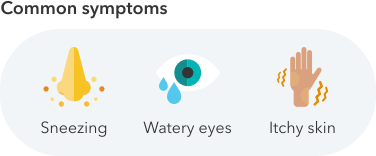Let's talk aboutDog Allergy
What is dog allergy?
Allergies occur when the immune system mistakes a normally harmless substance, called an allergen, for a harmful one. When the immune system detects an allergen, it triggers an immune reaction in an attempt to protect the body. In the case of dog allergy, the immune system reacts to certain proteins found in dogs’ saliva, skin cells (also called “dander”), or urine.
Symptoms of dog allergy
Those with dog allergies often experience sneezing, runny nose, watery eyes, and itchy skin. Some may experience signs of asthma, such as difficulty breathing or wheezing. For people with dog allergies, lifestyle modifications and other treatments, including medications, can help ease symptoms.

Did you know?
Certain dog breeds have been described as “hypoallergenic,” meaning they are unlikely to cause allergic reactions. Some propose that low-shedding breeds, like labradoodles, poodles, or cairn terriers, may release less allergens into the surroundings and cause fewer reactions. However, studies have shown that there is no significant difference between allergen levels inside homes of hypoallergenic dogs and non-hypoallergenic dogs. While it appears there is no correlation between dog breed and the amount of allergens released, some evidence suggests that regardless of breed, bathing dogs twice a week or more may help reduce allergic reactions. But keep in mind that over-washing may irritate the skin so this may not be suitable for all dogs.

Explore more
Curious whether you have an increased likelihood of developing a dog allergy based on your genetics? 23andMe takes into account more than 8,000 genetic markers to estimate the likelihood of developing a dog allergy. Find out more with the Dog Allergy Wellness report (Powered by 23andMe Research), part of the 23andMe+ Premium membership. 23andMe+ Premium includes everything in our Health + Ancestry Service plus new premium reports and features throughout the year.

23andMe+ Premium
References